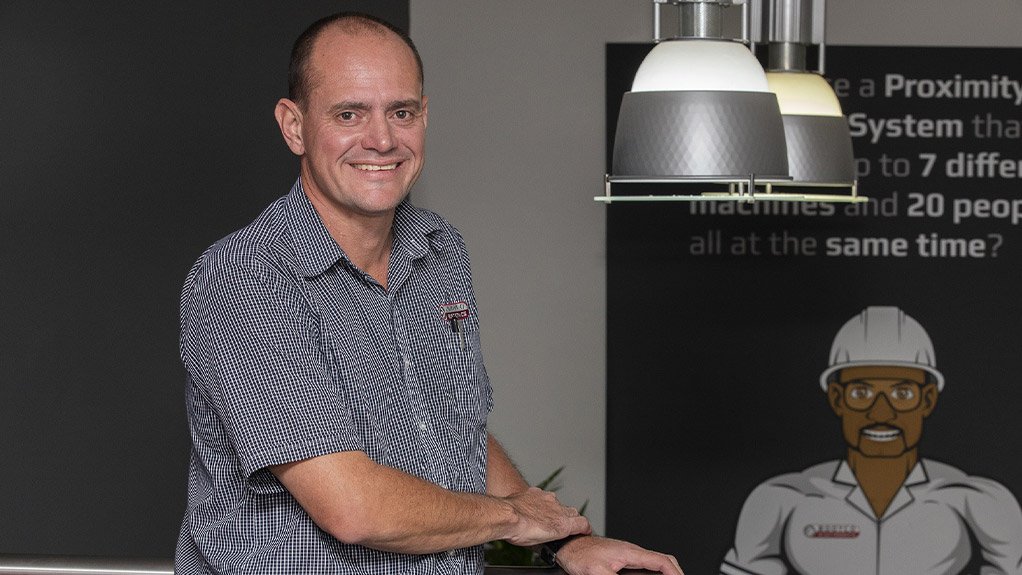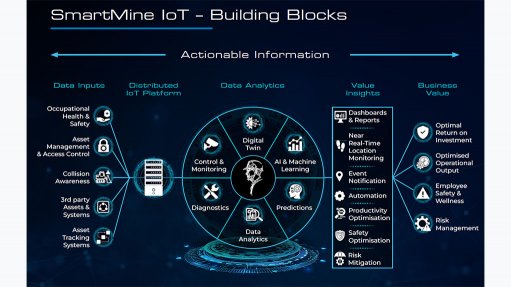Imminent surge in demand for PDS anticipated



ANTON LOURENS As the 2020 deadline approaches, many late adopters are going to rush to be made compliant
SPOT LIGHT The two-way radio frequency identification chip installed in the head lamp allows for pedestrians to be spotted by the proximity detection system
Mine safety equipment supplier Booyco Electronics CEO Anton Lourens is anticipating a surge in demand for proximity detection systems (PDS) next year.
In 2017, the then Department of Mineral Resources issued a 2020 deadline for mining companies to implement stipulations laid out in the 2015 amendments to Chapter 8 of the Mining Health and Safety Act (MHSA).
The deadline pertains to the safe use of diesel-powered trackless mobile machinery (TMM) in mines.
The updated legislation requires that mining companies complete a risk assessment before implementing PDS, which can audibly and visually warn operators of an imminent collision. This intervention requires the operator to act timeously in accordance with the warnings.
The amended legislation further stipulates that there must be some sort of automatic PDS intervention to prevent a collision if the operator fails to act. W
ith the possibility of enforced downtime because of noncompliance, Lourens expects late adopters of PDS technology to scurry to meet the 2020 deadline at the eleventh hour.
“A mining operation could potentially stand still until PDS are installed,” he warns.
Several adopters have delayed installing the systems because of the additional cost involved, and the frequent changes to mining legislation.
He applauds the number of early-adopting, proactive clients who have installed PDS, as this translates to improved safety on site, which is desirable, regardless of legislation.
Predictable & Safe
Booyco Electronics’ PDS can contribute to compliance. It uses a very low frequency and radio-frequency technology to facilitate collision detection, and incorporates automatic slowdown and fail-to-safe functionality for TMMs. The signal can effectively penetrate rock walls underground, rendering line-of-sight detection redundant.
It can detect up to seven TMMs and 20 pedestrians within one field in an underground environment, owing to the broadcasting technology. Lourens says that several other PDS solutions on the market use point-to-point technology, which is slower to respond.
Pedestrians are equipped with two-way radio-frequency identification (RFID) tags.
Vehicles are equipped with very low frequency antennas, which create two stable fields in front of and behind the vehicle.The system can be applied to older machines, as well as newer models which are controller area network bus-enabled.
Itcan also be applied to static danger zones.
When a pedestrian with an RFID tag enters the zone, the tag is activated and the warning signal is triggered, indicating to the pedestrian that they are entering a danger zone.
The vehicle operator is warned simultaneously. In underground applications, the system has a detection range of about 25 m on regular vehicles, depending on the number of antennas installed. For vehicle to vehicle, the detection range is up to 100 m.
The PDS can also be expanded to provide other functions, such as confirmation of shaft clearance, and can be integrated with time and attendance logging systems.
Moreover, the integrated Booyco Electronics Asset Management System enables the extraction of useful data on risk areas, which can assist in staff training.
Collective Responsibility
While the implementation of PDS might ensure that employers are fulfilling their duty in accordance with Section 21 of the MHSA, Lourens reflects on the need for employees to take responsibility for their safety too.
“If pedestrians don’t wear RFID tags, for example, then the machine won’t see them. Employees need to understand that it is for their own safety and they have to use the technology correctly,” Lourens notes.
“I started this business to save lives, and Booyco Electronics has saved several lives. However, the PDS requires end-user involvement and commitment to ensure that it works to its fullest potential,” he concludes.
Article Enquiry
Email Article
Save Article
Feedback
To advertise email advertising@creamermedia.co.za or click here
Comments
Press Office
Announcements
What's On
Subscribe to improve your user experience...
Option 1 (equivalent of R125 a month):
Receive a weekly copy of Creamer Media's Engineering News & Mining Weekly magazine
(print copy for those in South Africa and e-magazine for those outside of South Africa)
Receive daily email newsletters
Access to full search results
Access archive of magazine back copies
Access to Projects in Progress
Access to ONE Research Report of your choice in PDF format
Option 2 (equivalent of R375 a month):
All benefits from Option 1
PLUS
Access to Creamer Media's Research Channel Africa for ALL Research Reports, in PDF format, on various industrial and mining sectors
including Electricity; Water; Energy Transition; Hydrogen; Roads, Rail and Ports; Coal; Gold; Platinum; Battery Metals; etc.
Already a subscriber?
Forgotten your password?
Receive weekly copy of Creamer Media's Engineering News & Mining Weekly magazine (print copy for those in South Africa and e-magazine for those outside of South Africa)
➕
Recieve daily email newsletters
➕
Access to full search results
➕
Access archive of magazine back copies
➕
Access to Projects in Progress
➕
Access to ONE Research Report of your choice in PDF format
RESEARCH CHANNEL AFRICA
R4500 (equivalent of R375 a month)
SUBSCRIBEAll benefits from Option 1
➕
Access to Creamer Media's Research Channel Africa for ALL Research Reports on various industrial and mining sectors, in PDF format, including on:
Electricity
➕
Water
➕
Energy Transition
➕
Hydrogen
➕
Roads, Rail and Ports
➕
Coal
➕
Gold
➕
Platinum
➕
Battery Metals
➕
etc.
Receive all benefits from Option 1 or Option 2 delivered to numerous people at your company
➕
Multiple User names and Passwords for simultaneous log-ins
➕
Intranet integration access to all in your organisation
















